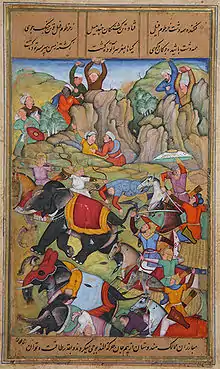| Battle of Delhi | |||||||
|---|---|---|---|---|---|---|---|
| Part of Timurid conquests and invasions and Campaigns of Timur | |||||||
 Map showing Timur's Invasion of India 1397-1399 | |||||||
| |||||||
| Belligerents | |||||||
|
|
| ||||||
| Commanders and leaders | |||||||
|
|
| ||||||
| Strength | |||||||
| 90,000 | Unknown | ||||||
| Casualties and losses | |||||||
| Unknown | Unknown | ||||||
The Sack of Delhi was a battle between Timur, founder of the Timurid Empire and the Delhi Sultanate. It took place on 17 December 1398 and lasted for 3 days, and ended with the massacre of over 100,000 citizens as well as the Delhi's Army.
Background
Timur gained power in 1370, he swiftly began engaging in wars and conquering many surrounding nations. While he conquered Persia, and Iraq, a civil war broke out in the Delhi Sultanate and by 1398, there were two rulers who called themselves Sultan: Nasir ud-Din Mahmud Shah Tughlaq, the grandson of Firuz Shah Tughlaq who ruled from Delhi, and Nasir ud-Din Nusrat Shah Tughlaq, another relative of Firuz Shah Tughlaq who ruled from Firozabad, which was a few miles from Delhi.[1] Timur who had heard about this quickly turned his eye on Delhi knowing about the rich wealth of India. Timur had begun preparations and mobilization for his next campaign. While Timur had no intention of ruling over India or interest in an Indian Empire, he certainly had an interest in the massive amount of wealth that India had.
The invasion of India 1398
In 1398, Timur gathered an army of over 90,000 to invade India with. On 30 September 1398 Timur crossed the Indus River and reached Tulamba where he sacked the city and massacred its inhabitants. In October he later reached Multan and the city captured. Most of his Invasion faced no fighting and almost no resistance by the Indians, as they were already weakened and had not mobilized properly.
Battle of Delhi

Sultan Nasir-ud-Din Mahmud Shah Tughluq and Mallu Iqbal had made preparations in Delhi to face Timur, their army consisted of war elephants with chain mail and poison on their tusks. But Timur was a strategist and devised a plan, he dug trenches around his Calvary units, as he had gathered that horses were easily frightened by elephants. In most cases Commanders dug trenches to protect infantry from cavalry yet Timur did the opposite, which boosted the morale of his army. Timur also knew that elephants panic easily, Timur loaded hay and wood onto the camels. The camels ran towards the war elephants. While the elephants were panicking, Timur and his army began to shoot arrows and catapults pots filled with inflammable liquids. The Delhi Army was poisoned by their own elephants, Timur then set loose of his main army and charged at Delhi's army, and Timur's Horsemen destroyed what was left of Sultan Nasir-ud-Din Mahmud Shah Tughluq's army. The city was sacked to ruins, and the population was enslaved. After the capture of the Sultanate's capital Delhi, the people unsatisfied of Timur began to revolt.It lasted for 3 days and the army left the decomposing bodies to give "food to the birds".
See also
Notes
- ↑ Smith 1920, pp. 248–254.
References
Smith, Vincent A. (1920). The Oxford History of India: From the Earliest Times to the End of 1911. Clarendon Press.